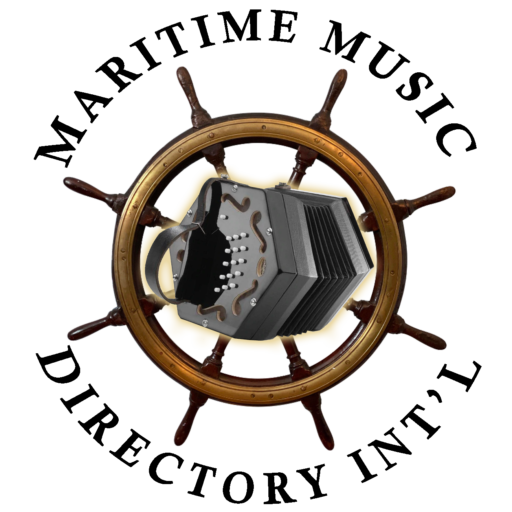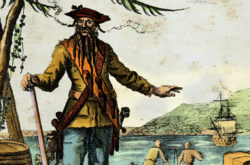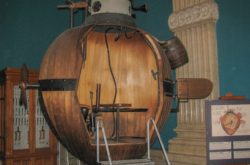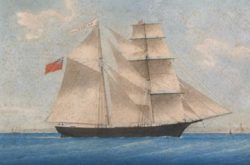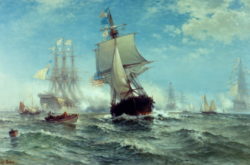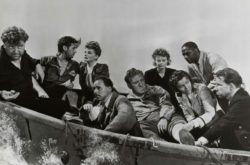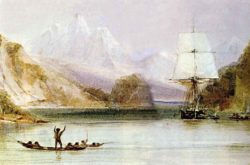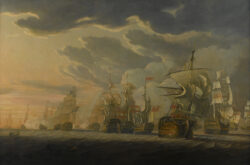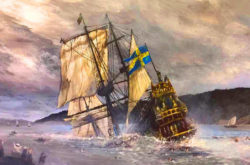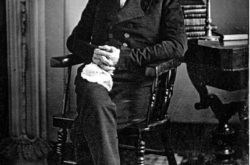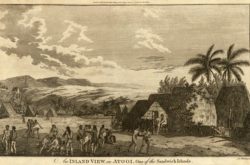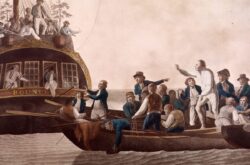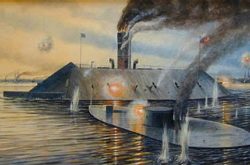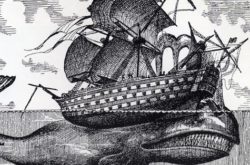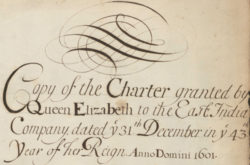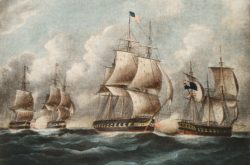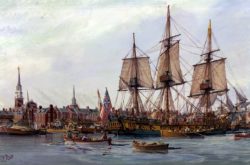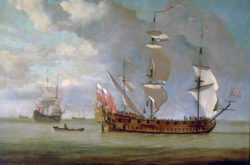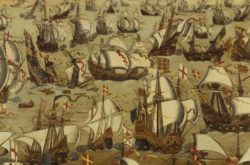Blackbeard Killed off North Carolina (1718)
Edward Teach, also known as Blackbeard, is killed on November 22, 1718, off North Carolina’s Outer Banks during a bloody battle with a British navy force sent from Virginia. Believed to be a native of England, Edward Teach likely began his pirating career in 1713, when he became a crewman aboard a Caribbean sloop commanded by pirate Benjamin Hornigold. In 1717, after Hornigold accepted an offer of general amnesty by the British crown and retired as a pirate, Teach took over a captured 26-gun French merchantman, increased its armament to 40 guns, and renamed it the Queen Anne’s Revenge. During the next six months, the Queen Anne’s Revenge served as the flagship of a pirate fleet featuring up to four vessels and more than 200 men. Teach became the most infamous pirate of his day, winning the popular name of Blackbeard for his long, dark beard, which he was said to light on fire during battles to intimidate his enemies. Blackbeard’s pirate forces terrorized the Caribbean and the southern coast of North America and were notorious for their cruelty. In May 1718, the Queen Anne’s Revenge and another vessel were shipwrecked, forcing Blackbeard to desert a third ship and most of his men because of a lack of supplies. With the single remaining ship, Blackbeard sailed to Bath in North Carolina and met with Governor Charles Eden. Eden agreed to pardon Blackbeard in exchange for a share of his sizable booty. Read the complete article here.
Defeat Armada 1588
England Defeats Spanish Armada (1588) On July 29, 1588 England defeats the Spanish Armada Off the coast of Gravelines, France, Spain’s so-called “Invincible Armada” is defeated by an English naval force under the command of Lord Charles Howard and Sir Francis Drake. After eight hours of furious fighting, a change in wind direction prompted the Spanish to break off from the battle and retreat toward the North Sea. Its hopes of invasion crushed, the remnants of the Spanish Armada began a long and difficult journey back to Spain. Link to full article on History.com.
World’s First Submarine Attack (Sept. 7, 1776)
On September 7, 1776, during the Revolutionary War, the American submersible craft Turtle attempts to attach a time bomb to the hull of British Admiral Richard Howe’s flagship Eagle in New York Harbor. It was the first use of a submarine in warfare. Submarines were first built by Dutch inventor Cornelius van Drebel in the early 17th century, but it was not until 150 years later that they were first used in naval combat. David Bushnell, an American inventor, began building underwater mines while a student at Yale University. Deciding that a submarine would be the best means of delivering his mines in warfare, he built an eight-foot-long wooden submersible that was christened the Turtle for its shape. Large enough to accommodate one operator, the submarine was entirely hand-powered. Lead ballast kept the craft balanced. Read full article in History.com
The Mary Celeste is spotted at sea (5 Dec 1872)
The Mary Celeste, a ship whose crew mysteriously disappeared, is spotted at sea. The Dei Gratia, a small British brig under Captain David Morehouse, spots the Mary Celeste, an American vessel, sailing erratically but at full sail near the Azores Islands in the Atlantic Ocean. The ship was seaworthy, its stores and supplies were untouched, but not a soul was onboard. Read the full article on History.com.
John Paul Jones wins in English waters (23 Sept 1779)
During the American Revolution, the U.S. ship Bonhomme Richard, commanded by John Paul Jones, wins a hard-fought engagement against the British ships of war Serapis and Countess of Scarborough, off the eastern coast of England. Scottish-born John Paul Jones first sailed to America as a cabin boy and lived for a time in Fredericksburg, Virginia, where his brother had a business. He later served on slave and merchant ships and proved an able seaman. After he killed a fellow sailor while suppressing a mutiny, he returned to the American colonies to escape possible British prosecution. With the outbreak of the American Revolution in 1775, he traveled to Philadelphia and was commissioned a senior lieutenant in the new Continental Navy. He soon distinguished himself in actions against British ships in the Bahamas, the Atlantic Ocean and the English Channel. Read complete article on History.com
Hollywood and the Sea:
Maritime History & Culture in Film
Register Here for the Zoom Seminar Saturday, 5 November 2022Welcome & Lecture at 11:00 AM ET, Q&A to Follow Seminars are free to attend, although we hope you will support the Series with a suggested $10 Seminar Guest donation. You won’t want to miss this special seminar with SUNY Maritime Professor Dr. John Rocco for an overview of one of his most popular courses, Hollywood and the Sea: Maritime Culture and Film. The seminar will explore Hollywood’s depiction of the maritime realms of war, work, law, and discovery, examining important themes and subjects raised by the films—the voyage narrative, American whaling, famous naval battles, slavery, World War II, and maritime crime and punishment. Dr. Rocco will guide us through the history of maritime Hollywood through the work of directors such as Buster Keaton, Michael Curtiz, Alfred Hitchcock, Howard Hawks, John Ford, Elia Kazan, Edward Dmytryk, John Huston, Francis Ford Coppola, and Steven Spielberg. For an early look at some of the films Dr. Rocco highlights in his course, see Steamboat Bill, Jr. (1928), Down to the Sea in Ships (1922), Mutiny on the Bounty (1935 and 1962), Two Years Before the Mast (1946), Moby Dick (1930 and 1956), Captain Blood (1935), The Long Voyage Home (1940), Mister Roberts (1955), The Battle of Midway (1942), They Were Expendable (1945), Action in the North Atlantic (1943), The African Queen (1951), The Caine Mutiny (1954), On the Waterfront (1954), To Have and Have Not (1944), The Breaking Point (1950), Jaws (1975), Amistad (1997), and Apocalypse Now (1979). About the SpeakerIn addition to being a well-loved professor of composition, literature, film, and other graduate studies, Dr. Rocco is also an author and the coordinator of the Maritime and Naval Studies (MNST) master’s program at SUNY Maritime. He has long been involved with digitizing years of records from Sailors’ Snug Harbor and received the SUNY Chancellor’s Award for Excellence in Teaching.
Darwin Returns to Falmouth 2 Oct 1831
The British naturalist Charles Darwin returns to Falmouth, England, aboard the HMS Beagle, ending a five-year surveying expedition of the southern Atlantic and Pacific oceans. Visiting such diverse places as Brazil, the Galapagos Islands, and New Zealand, Darwin acquired an intimate knowledge of the flora, fauna, and geology of many lands. This information proved invaluable in the development of his theory of evolution, first put forth in his groundbreaking scientific work of 1859, The Origin of Species by Means of Natural Selection. Darwin’s theory argued that organisms gradually evolve through a process he called “natural selection.” In natural selection, organisms with genetic variations that suit their environment tend to propagate more descendants than organisms of the same species that lack the variation, thus influencing the overall genetic makeup of the species. His Origin of Species, the first significant work on the theory of evolution, was greeted with great interest in the scientific world but was attacked by religious leaders for its contradiction of the biblical account of creation. Read a complete article on National Geographic’s website: https://education.nationalgeographic.org/resource/hms-beagle-darwins-trip-around-world
Battle of Cape St. Vincent (1797)
The Battle of Cape St. Vincent (14 February 1797) was one of the opening battles of the Anglo-Spanish War (1796–1808), as part of the French Revolutionary Wars, where a British fleet under Admiral Sir John Jervis defeated a greatly superior Spanish fleet under Admiral Don José de Córdoba y Ramos near Cape St. Vincent, Portugal. https://en.wikipedia.org/wiki/Battle_of_Cape_St._Vincent_(1797)
Vasa departs Stockholm and Sinks (1628)
Vasa is a Swedish warship built between 1626 and 1628. The ship sank after sailing roughly 1,300 m (1,400 yd) into her maiden voyage on 10 August 1628. She fell into obscurity after most of her valuable bronze cannon were salvaged in the 17th century, until she was located again in the late 1950s in a busy shipping area in Stockholm harbor. The ship was salvaged with a largely intact hull in 1961. She was housed in a temporary museum called Wasavarvet (“The Vasa Shipyard”) until 1988 and then moved permanently to the Vasa Museum in the Royal National City Park in Stockholm. The ship is one of Sweden’s most popular tourist attractions and has been seen by over 35 million visitors since 1961. Since her recovery, Vasa has become a widely recognized symbol of the Swedish Empire. Link to full article on Wikipedia.
John Quincy Adams begins arguments in Amistad case
On February 24, 1841, former President John Quincy Adams begins to argue the Amistad case in front of the U.S. Supreme Court. A practicing lawyer and member of the House of Representatives, John Quincy Adams was the son of America’s second president, founding father and avowed abolitionist John Adams. Although John Quincy Adams publicly downplayed his abolitionist stance, he too viewed the practice as contrary to the nation’s core principles of freedom and equality. After serving one term as president between 1825 and 1829, Adams was elected to the House of Representatives, in which he served until his death in 1848. During his tenure, he succeeded in repealing a rule that prevented any debate about slavery on the House floor. Read the complete article on History.com. For further reading, please see this article.
Henry Hudson Set Adrift
Henry Hudson Set Adrift by mutineers (June 22, 1611) After spending a winter trapped by ice in present-day Hudson Bay, the starving crew of the Discovery mutinies against its captain, English navigator Henry Hudson, and sets him, his teenage son, and seven supporters adrift in a small, open boat. Hudson and the eight others were never seen again. Link to full article on History.com
Captain Cook Reaches Hawaii
On January 18, 1778, the English explorer Captain James Cook becomes the first European to travel to the Hawaiian Islands when he sails past the island of Oahu. Two days later, he landed at Waimea on the island of Kauai and named the island group the Sandwich Islands, in honor of John Montague, who was the earl of Sandwich and one his patrons. In 1768, Cook, a surveyor in the Royal Navy, was commissioned a lieutenant in command of the H.M.S. Endeavor and led an expedition that took scientists to Tahiti to chart the course of the planet Venus. In 1771, he returned to England, having explored the coast of New Zealand and Australia and circumnavigated the globe. Beginning in 1772, he commanded a major mission to the South Pacific and during the next three years explored the Antarctic region, charted the New Hebrides, and discovered New Caledonia. In 1776, he sailed from England again as commander of the H.M.S. Resolution and Discovery and in 1778 made his first visit to the Hawaiian Islands. Read the complete article on History.com.
Mutiny on the HMS Bounty (April 28, 1789)
Three weeks into a journey from Tahiti to the West Indies, the HMS Bounty is seized in a mutiny led by Fletcher Christian, the master’s mate. Captain William Bligh and 18 of his loyal supporters were set adrift in a small, open boat, and the Bounty set course for Tubuai south of Tahiti. Read the complete article on History.com.
USS Monitor Sinks (1862)
On December 30, 1862, the U.S.S. Monitor sinks in a storm off Cape Hatteras, North Carolina. Just nine months earlier, the ship had been part of a revolution in naval warfare when the ironclad dueled to a standstill with the C.S.S. Virginia (Merrimack)off Hampton Roads, Virginia, in one of the most famous naval battles in American history–the first time two ironclads faced each other in a naval engagement. (Note that while we try to limit these articles to feature tall ships from the Age of Sail, this development was signature to the end of the era.) Read the complete article on History.com.
Whaleship Essex Sunk by Sperm Whale
The American whaler Essex, which hailed from Nantucket, Massachusetts, is attacked by an 80-ton sperm whale 2,000 miles from the western coast of South America. The 238-ton Essex was in pursuit of sperm whales, specifically the precious oil and bone that could be derived from them, when an enraged bull whale rammed the ship twice and capsized the vessel. The 20 crew members escaped in three open boats, but only five of the men survived the harrowing 83-day journey to the coastal waters of South America, where they were picked up by other ships. Most of the crew resorted to cannibalism during the long journey, and at one point men on one of the long boats drew straws to determine which of the men would be shot in order to provide sustenance for the others. Three other men who had been left on a desolate Pacific island were saved later. The first capture of a sperm whale by an American vessel was in 1711, marking the birth of an important American industry that commanded a fleet of more than 700 ships by the mid 18th century. Herman Melville’s classic novel Moby Dick (1851) was inspired in part by the story of the Essex. Read the Complete article on History.com.
Charter granted to the East India Company (31 Dec 1600)
On December 31, 1600, Queen Elizabeth I of England grants a formal charter to the London merchants trading to the East Indies, hoping to break the Dutch monopoly of the spice trade in what is now Indonesia. In the first few decades of its existence, the East India Company made far less progress in the East Indies than it did in India itself, where it acquired unequaled trade privileges from India’s Mogul emperors. By the 1630s, the company abandoned its East Indies operations almost entirely to concentrate on its lucrative trade of Indian textiles and Chinese tea. In the early 18th century, the company increasingly became an agent of British imperialism as it intervened more and more in Indian and Chinese political affairs. The company had its own military, which defeated the rival French East India Company in 1752 and the Dutch in 1759. Read the complete article on History.com.
Battle of Lake Erie (Sept. 10, 1813)
In the first unqualified defeat of a British naval squadron in history, U.S. Captain Oliver Hazard Perry leads a fleet of nine American ships to victory over a squadron of six British warships at the Battle of Lake Erie during the War of 1812. The battle was closely contested for hours, and Perry’s flagship Lawrence was reduced to a defenseless wreck. He then transferred to the Niagara and sailed directly into the British line, firing broadsides and forcing the British to surrender. Perry had won a complete victory at the cost of 27 Americans killed and 96 wounded; British casualties were 40 dead and 94 wounded. After the battle, Perry sent a famous dispatch to U.S. General William Henry Harrison that read, “We have met the enemy, and they are ours.” The Battle of Lake Erie forced the British to abandon Detroit, ensuring U.S. control over Lake Erie and the territorial northwest.Read the full article on History.com
Founding of the US Navy (13 Oct 1775)
The United States Navy claims October 13, 1775 as the date of its official establishment, when the Second Continental Congress passed a resolution creating the Continental Navy. With the end of the American Revolutionary War, the Continental Navy was disbanded. – Wikipedia 3/27/2020. On October 13, 1775, the Continental Congress authorizes construction and administration of the first American naval force—the precursor to the United States Navy. Read the complete article here on History.com.
Captain Kidd Dies (1701)
At London’s Execution Dock, British privateer William Kidd, popularly known as Captain Kidd, is hanged for piracy and murder. Born in Strathclyde, Scotland, Kidd established himself as a sea captain before settling in New York in 1690, where he bought property and married. At various times he was commissioned by New York and other American colonies to rid the coast of enemy privateers. In 1695, while on a trip to London, the recently appointed governor of New York commissioned him to defend English ships from pirates in the Red Sea. In 1696, Kidd sailed to New York aboard the Adventure Galley, enlisted men for the mission, and set sail for the Indian Ocean. The expedition met with little success and failed to capture a major prize until February 1698, when the Quedagh Merchant, an Indian vessel allegedly sailing under a French pass, was taken. Word of Kidd’s capture of the boat, which was loaded with gold, jewels, silk, sugar and guns, aroused significant controversy in Britain, as the ship had an English captain. Read the complete article on History.com.
Spanish Armada sets sail to secure English Channel (1588)
On May 19, 1588 a massive Spanish fleet, known as the “Invincible Armada,” sets sail from Lisbon on a mission to secure control of the English Channel and transport a Spanish invasion army to Britain from the Netherlands. [This historic engagement inspired many contemporary songs, as well as songs looking back on the action, including a 1982 rendition by Peter Bellamy of “The Spanish Armada” on his collection, The Maritime England Suite. This song was crafted from a poem written by John O’Keefe, published in 1902.] Read the complete article on History.com.
